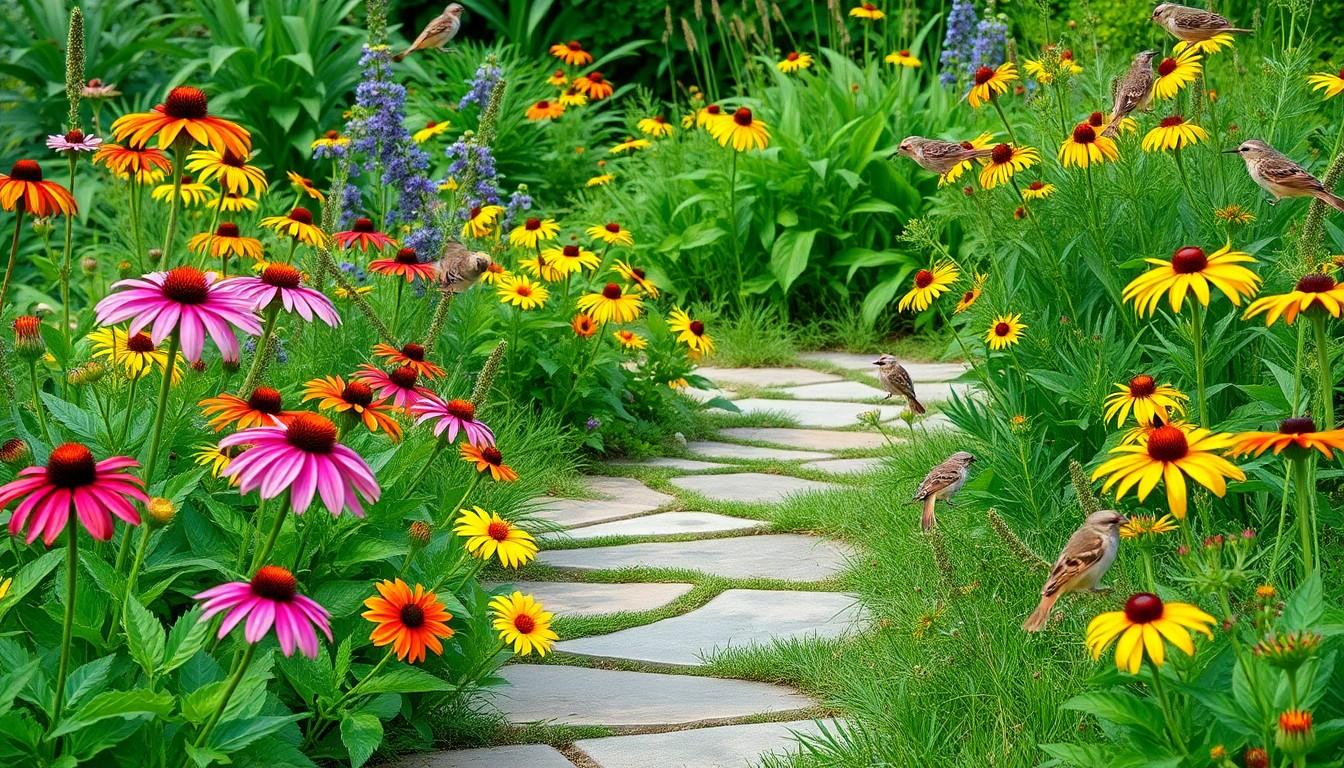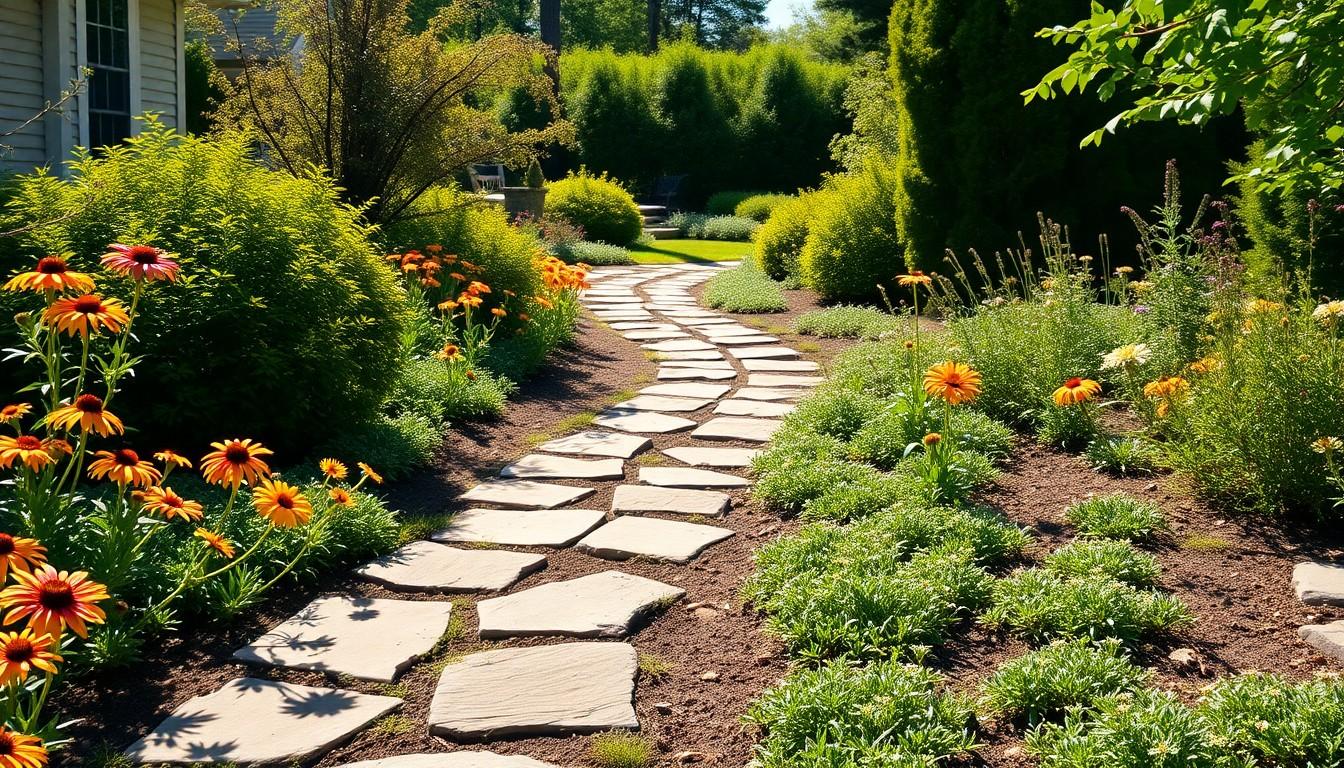Imagine stepping into a backyard that feels like a serene escape rather than a chaotic jungle. Natural landscaping transforms ordinary yards into stunning retreats, inviting both relaxation and wildlife. It’s not just about pretty plants; it’s about creating a harmonious environment that benefits both nature and the homeowner.
natural landscaping ideas
Natural landscaping blends aesthetics with functionality, creating beautiful outdoor spaces that encourage biodiversity. Incorporating native plants fosters a strong connection to the local ecosystem. Flowering species such as coneflowers and black-eyed Susans attract pollinators, benefiting both gardens and surrounding environments.
Using shrubs like elderberries and serviceberries provides both habitat and food for wildlife, while their hardy nature ensures minimal maintenance. Additionally, ground cover plants such as creeping thyme and sedum help control erosion, making them practical choices for slopes.
Pathways crafted from natural materials enhance functionality and visual appeal. Stone pavers or wood mulch lend an organic feel, guiding visitors through landscaped areas without disrupting the natural flow. Fountains and water features introduce calming sounds that promote relaxation, enhancing the ambiance of outdoor living spaces.
Creating zones within the yard fosters various uses and experiences. A shaded seating area invites relaxation, while a sunlit patch encourages gardening. Transitioning between these areas can be achieved with natural elements like boulders or perennial flower beds.
Incorporating organic mulch around plants minimizes weed growth and retains moisture, creating healthier soil. This approach not only promotes sustainability but also reduces the need for chemical fertilizers. Native grasses and flowers contribute to low-maintenance landscaping, appealing to environmentally conscious homeowners.
The combination of these elements results in a vibrant outdoor sanctuary. Emphasizing natural processes enhances the overall health of the ecosystem, benefiting not only human occupants but wildlife as well. Natural landscaping ideas lead to serene retreats that require minimal upkeep, offering both beauty and functionality.
Benefits of Natural Landscaping

Natural landscaping offers numerous advantages, enhancing both the environment and personal spaces. It encourages harmony between nature and residential areas.
Environmental Impact
Natural landscaping significantly improves local ecosystems. Native plants increase biodiversity, creating habitats for local wildlife. Pollinators such as bees and butterflies thrive in gardens filled with native flowering species. Eco-friendly practices help reduce water usage through plants that require less irrigation. Organic mulch enhances soil health by retaining moisture and suppressing weeds. Additionally, natural landscaping promotes erosion control, particularly with ground cover plants. These practices contribute to healthier surroundings, support wildlife populations, and create a balanced ecosystem.
Aesthetic Appeal
Natural landscaping enhances the visual charm of outdoor spaces. Varying textures and colors from native plants create an inviting atmosphere. Pathways made from unrefined materials add rustic allure and guide visitors through the garden. Seasonal blooms, such as coneflowers and black-eyed Susans, provide continuous interest year-round. Shrubs like elderberries and serviceberries introduce depth while also offering food and shelter for wildlife. Creating distinct zones in the landscape allows for versatile functionality in outdoor living. Overall, the aesthetics of natural landscaping invite tranquility and enjoyment in any yard.
Popular Natural Landscaping Ideas
Natural landscaping offers various creative possibilities that enhance outdoor spaces while supporting local ecosystems. Here are some popular ideas to implement in any garden.
Native Plant Gardens
Native plant gardens prioritize local flora, promoting biodiversity. These gardens attract pollinators like bees and butterflies, which thrive on flowering species such as coneflowers and black-eyed Susans. Utilizing shrubs, like elderberries and serviceberries, creates habitats for wildlife and provides sources of food. Ground cover plants, such as creeping thyme and sedum, help manage erosion effectively. Integrating these species fosters a vibrant ecosystem that requires minimal maintenance and sustains itself over time.
Rock Gardens
Rock gardens utilize natural stones to create visually appealing structures. These landscapes allow for unique designs and highlight drought-resistant plants, which thrive in lean soil conditions. Succulents and alpine plants such as sedums and saxifrages grow wonderfully in these environments. Incorporating boulders and smaller rocks adds depth and character, making spaces inviting for both people and wildlife. The inclusion of pathways through the rocks can enhance accessibility while offering serene spots for relaxation.
Rain Gardens
Rain gardens collect stormwater runoff, promoting sustainable drainage solutions. Positioned in low-lying areas, these gardens capture excess water and filter pollutants, benefiting the environment. Plants like native ferns and wetland grasses thrive in these gardens while providing habitats for various creatures. The diversity in plants enhances aesthetics and functionality, creating tranquil landscapes that contribute to better water management. This practice reduces flooding risk, making rain gardens both practical and beautiful in any home landscaping project.
Tips for Implementing Natural Landscaping
Implementing natural landscaping requires careful planning and consideration. Prioritizing functionality and aesthetics remains crucial for creating an inviting outdoor space.
Choosing the Right Plants
Selecting native plants enriches the landscape. Coneflowers and black-eyed Susans attract pollinators, while elderberries and serviceberries support local wildlife. Groups of perennials provide varied blooms throughout the seasons, enhancing visual interest. Local nurseries often carry species suited for specific climates, providing options that thrive in the area. Additionally, using ground cover plants like creeping thyme and sedum controls erosion and minimizes maintenance. Combining textures and colors from these plants fosters an engaging environment, inviting visitors to appreciate the diversity found in natural landscapes.
Soil and Water Considerations
Understanding soil conditions is essential for successful landscaping. Conducting a soil test reveals pH levels and nutrient content, guiding amendment choices. Incorporating organic mulch improves soil quality, promoting beneficial organisms. Native plants typically require less water, reducing demands on local water supplies. Rain gardens effectively manage stormwater runoff, featuring plants that thrive in wet conditions while filtering pollutants. Mulching around plants conserves moisture and suppresses weeds, supporting healthier growth. Ensuring plants receive adequate moisture without over-watering enhances resilience, promoting sustainability in the landscaping effort.
Natural landscaping offers a unique opportunity to enrich outdoor spaces while promoting environmental sustainability. By incorporating native plants and eco-friendly practices, homeowners can create beautiful gardens that support local wildlife and enhance biodiversity.
With thoughtful planning and the right plant selections, it’s possible to transform any yard into a tranquil retreat. The benefits extend beyond aesthetics, as these landscapes contribute to healthier ecosystems and reduce maintenance efforts. Embracing natural landscaping not only beautifies personal spaces but also fosters a deeper connection to nature.

